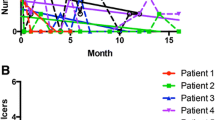Abstract
The clinical course of Behcet’s disease (BD) as a multisystemic disorder with a remitting-relapsing nature is insufficiently explored. As complete remission should be aimed in all inflammatory diseases, we investigated the frequency of complete remission in patients with BD followed in long-term, routine practice. In this retrospective study, 258 patients with BD who were regularly followed in outpatient clinics were assessed. The demographic and clinical data for active organ manifestations and treatment protocols were evaluated, and “complete remission” for this study was defined as no sign of any disease manifestation in the current visit and the preceding month. Two hundred fifty-eight patients with BD (F/M 130/128, mean age 41.1 ± 11.5 years) were included to the study. Mucocutaneous disease was present in 48.4 % (n = 125). Mean visit number was 6.8 ± 2.7, and mean follow-up duration was 45.8 ± 36.5 months. Patients were clinically active in 67.2 % (n = 1,182) of the total visits (n = 1,757), which increased to 75.6 % (68.1–90.3) when the month preceding the visit was also included. The most common active manifestation was oral ulcers (39.4–63.2 %) followed by other mucocutaneous manifestations and musculoskeletal involvement. When multivariate analysis was performed, oral ulcers, which are the main cause of the clinical activity, negatively correlated with immunosuppressive treatments (β = −0.356, p < 0.000) and age (β = −0.183, p = 0.04). It is fairly difficult to achieve complete remission in BD with current therapeutic regimens. The reluctance of the clinician to be aggressive for some BD manifestations with low morbidity, such as mucocutaneous lesions and arthritis, might be influencing the continuous, low-disease activity state, especially due to oral ulcers, in BD patients.

Similar content being viewed by others
Abbreviations
- BD:
-
Behcet’s disease
- CR:
-
complete remission
- OU:
-
oral ulcers
- IS:
-
immunosuppressive
- OI:
-
ocular involvement
- VI:
-
vascular involvement
- NI:
-
neurological involvement
- MI:
-
musculoskeletal involvement
- V:
-
visit
- CA:
-
clinical activity
- GU:
-
genital ulcer
- EN:
-
erythema nodosum
- PPL:
-
papulopustular lesion
References
Sakane T, Takeno M, Suzuki N, Inaba G (1999) Behcet’s disease. N Engl 341:1284–1291
Hughes T, Coit P, Adler A, Yilmaz V, Aksu K, Düzgün N et al (2013) Identification of multiple independent susceptibility loci in the HLA region in Behçet's disease. Nat Genet 45(3):319–324. doi:10.1038/ng.2551
Mumcu G, Inanc N, Yavuz S, Direskeneli H (2007) The role of infectious agents in the pathogenesis, clinical manifestations and treatment strategies in Behçet's disease. Clin Exp Rheumatol 25(4 Suppl 45):S27–S33
Haraoui B, Smolen JS, Aletaha D, Breedveld FC, Burmester G, Codreanu C et al (2011) Treating rheumatoid arthritis to target: multinational recommendations assessment questionnaire. Ann Rheum Dis 70(11):1999–2002. doi:10.1136/ard.2011.154179
Mosca M, Boumpas DT, Bruce IN, Cervera R, Czirjak L, Dörner T et al (2012) Treat-to-target in systemic lupus erythematosus: where are we today? Clin Exp Rheumatol 30(4 Suppl 73):S112–S115
Luqmani RA (2012) Treat-to-target in vasculitis: is this a sensible approach? Clin Exp Rheumatol 30(4 Suppl 73):S149–S153
Jung YS, Hong SP, Kim TI, Kim WH, Cheon JH (2012) Long-term clinical outcomes and factors predictive of relapse after 5-aminosalicylate or sulfasalazine therapy in patients with intestinal Behcet disease. J Clin Gastroenterol 46(5):e38–e45. doi:10.1097/MCG.0b013e3182431d56
Handa T, Tsunekawa H, Yoneda M, Watanabe D, Mukai T, Yamamura M, Iwaki M, Zako M (2011) Long-term remission of ocular and extraocular manifestations in Behçet's disease using infliximab. Clin Exp Rheumatol 29(4 Suppl 67):S58–S63
Adler S, Baumgartner I, Villiger PM (2012) Behçet's disease: successful treatment with infliximab in 7 patients with severe vascular manifestations. A retrospective analysis. Arthritis Care Res (Hoboken) 64(4):607–611. doi:10.1002/acr.21557
Pipitone N, Olivieri I, Padula A, D’angelo S, Nigro A, Zuccoli G et al (2008) Infliximab for the treatment of Neuro-Behçet's disease: a case series and review of the literature. Arthritis Rheum 59(2):285–290. doi:10.1002/art.23345
International Study Group for Behçet’s Disease (1990) Criteria for diagnosis of Behçet’s disease. Lancet 335:1078–1080
Hatemi G, Bahar H, Uysal S, Mat C, Gogus F, Masatlioglu S, Altas K, Yazici H (2004) The pustular skin lesions in Behcet’s syndrome are not sterile. Ann Rheum Dis 63(11):1450–1452
Mumcu G, Ergun T, Elbir Y, Eksioglu-Demiralp E, Yavuz S, Atalay T, Direskeneli H (2005) Clinical and immunological effects of azithromycin in Behçet’s disease. J Oral Pathol Med 34(1):13–16
Cosgun S, Seyahi E, Mat C, Yazici H (2004) Female Behçet’s syndrome have more severe oral ulceration. XI. International Congress on Behçet’s Disease. Clin Exp Rheum 22:86
Mumcu G, Sur H, Inanc N, Karacayli U, Cimilli H, Sisman N, Ergun T, Direskeneli H (2009) A composite index for determining the impact of oral ulcer activity in Behcet’s disease and recurrent aphthous stomatitis. J Oral Pathol Med 38(10):785–791. doi:10.1111/j.1600-0714.2009.00803.x
Tursen U, Gurler A, Boyvat A (2003) Evaluation of clinical findings according to sex in 2313 Turkish patients with Behçet’s disease. Int J Dermatol 42(5):346–351
Mumcu G, Inanc N, Ergun T, Ikiz K, Gunes M, Islek U et al (2006) Oral health related quality of life is affected by disease activity in Behcet’s disease. Oral Dis 12:145–151
Mumcu G, Hayran O, Ozalp DO, Inanc N, Yavuz S, Ergun T, Direskeneli H et al (2007) The assessment of oral health related quality of life by factor analysis in patients with Behcet disease and recurrent apthous stomatitis. J Oral Pathol Med 36:147–152
Disclosures
None.
Author information
Authors and Affiliations
Corresponding author
Rights and permissions
About this article
Cite this article
Alibaz-Oner, F., Mumcu, G., Kubilay, Z. et al. Unmet need in Behcet’s disease: most patients in routine follow-up continue to have oral ulcers. Clin Rheumatol 33, 1773–1776 (2014). https://doi.org/10.1007/s10067-014-2585-3
Received:
Revised:
Accepted:
Published:
Issue Date:
DOI: https://doi.org/10.1007/s10067-014-2585-3




